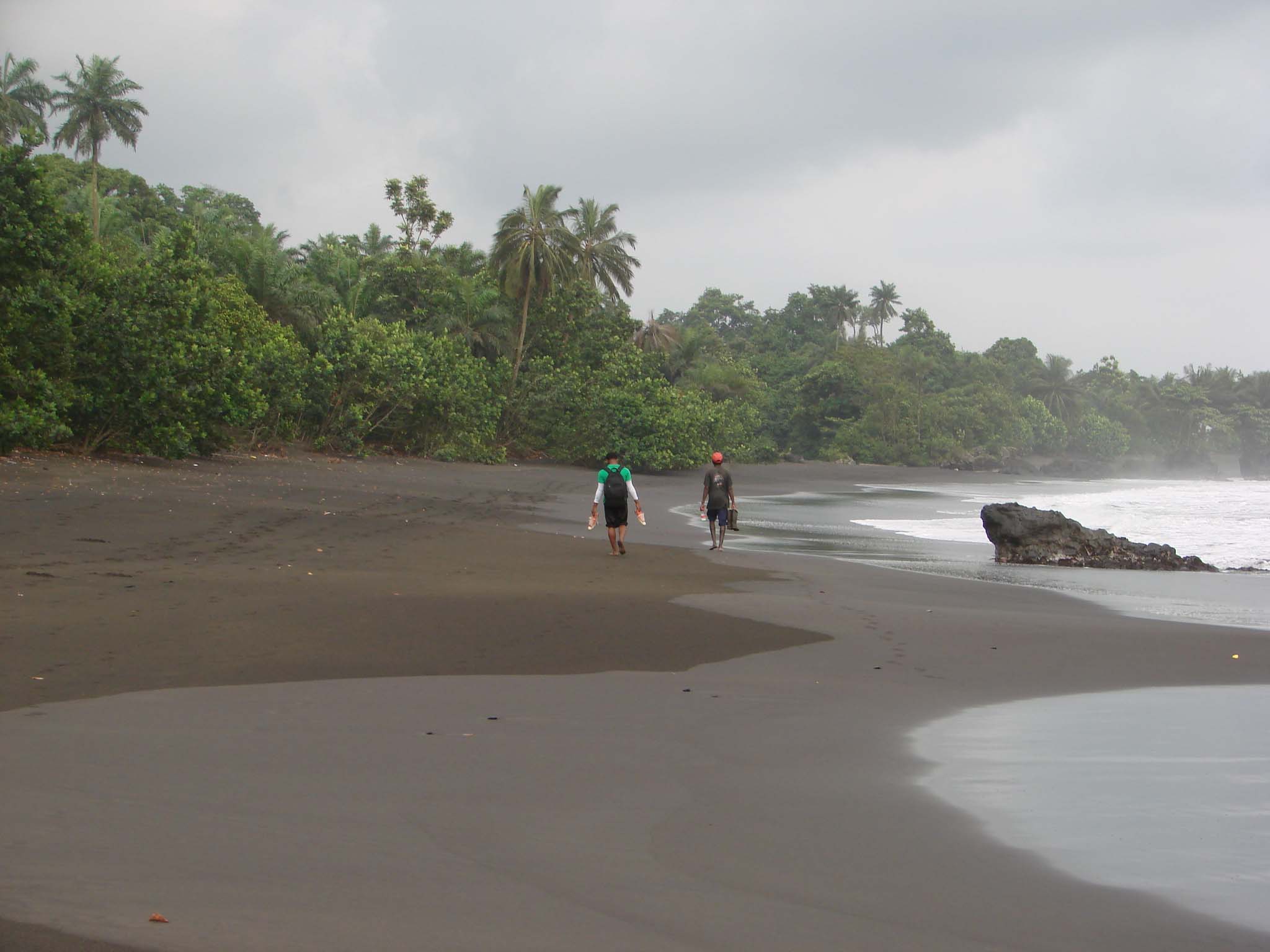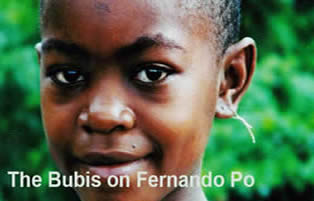 Bioko's beaches are frequented by Bubis walking from village to village. (Truelsen photo)
Bioko's beaches are frequented by Bubis walking from village to village. (Truelsen photo)
Chapter 54: Balacha of San Carlos
This mountainous region of San Carlos Bay, sadly famous from events in July of 1910 that occurred following a decree concerning the work of the Bubis, is one of the most picturesque and healthy places on the island. By day western breezes blow through and by night winds blow through the Sosó mountain pass, which gives passage from San Carlos to Ureka. If it had an abundance of water such as is in Musola, it would be the ideal region of Fernando Poo. It lacks the excessive humidity of the Biapa plateau, with its abrupt atmospheric changes, and is more accessible and nearer to the beach. From its mountains one discerns a varied, expansive panorama: all the eastern part of the island, from Bokoko to Europa Point and the foothills of the east, the Lopeló or Fernando Poo mountain chain, the heights of Basupú of the West, and, beyond all, a vast, level sea.
The Balachas are distinguished among the other Bubis for their sobriety, robust strength, and their application to work. They are the most retrogressive and obstinate in adapting to changing civilization. They are very attached to the laws and customs of their parents, and they kept, until a short while ago, their savage tattoo that, thanks to God and to the efforts of the Catholic missionaries, has disappeared completely from the island.
Since 1889 this district has been visited by the missionaries of Batete, and later by those of Musola and, finally, by those of the San Carlos mission. Previously, it had been attended to by the Methodists, but they abandoned these people after their visits and efforts to civilize them were in vain. At the present time, an immense majority of the children and young adults are Catholic.
The Balacha district comprises the villages of Relebó, Rohemeriba or Rutoloeri, Riokoricho or Riokobocho, and Ruiché or Rachá. Although each village has its own chief, all the subjects are tributaries to the principal chief of the district of Ombori, or to the successor of Sebbe Luba, who is today a legal, not natural, son of his. His name is Zaqueo Tabori, but he calls himself Rolando Luba.
The principal spirit, morimó, to whom the Balachas pay particular homage, is Lombe. There is an ancient tradition that says Lombe was a motuku of utmost wealth and power, deeply concerned for the well-being and prosperity of his countrymen. He traveled to all the regions of the island hoping to be accepted as motuku or king of them all, but as might be expected from these naturally austere people, they threw him out of their villages. Only the Balachas embraced him with benevolence and raised him up with enthusiasm as their king and master.
He established his court on a mysterious and solitary knoll that today holds a lagoon bearing his name. He distinguished himself and his government for their benignity, their clemency with the poor and lowly, and their thoroughness and severity in dealing with the arrogant and haughty. In all things he conducted himself with temperance and moderation. This king, nevertheless, was quite strict with the women born in Balacha. He required them to abstain from all types of meat and its broth, and to nourish themselves their entire lives from fresh fish, salted and in preserve, and from other seafood. This is the reason that the women of San Carlos (balachari or “of Balacha”) come down to the beach almost daily for fish. They carry out this arduous law scrupulously. There is no balachari who dares to break this law while she remains in the besé, for fear of sudden death. Only when they abandon Bubi life and leave to live with foreigners, will some, but not all, dare its violation.
In antiquity, Urekano fishermen supplied the balachari with fresh or smoked fish in exchange for yams, malangas and other fruits. But today the women themselves go to the San Carlos beaches, as we have just noted, as it is much closer and, in addition, because relations between the Balachas and Urekanos are not so close and cordial as in times past.
At the death of Lombe, all the villages of Balacha elected him for their principal patron. To him they appeal to remedy their misfortunes, to him they profess singular devotion, and to him they sacrifice goats and other animals, pouring the blood into the water of his lagoon. The father of Lombe was Eri, whose name a small marsh near Sosó bears.
I asked the Balachas in 1915 if they would be content if the Fathers were to put a mission in those heights. They responded to me: “Loomo (very much); but we fear a grave danger, because where the missionaries permanently establish themselves, it follows that the government places a military post, and we flee from the molestation of commandants and police.”
The Bubis used to have a supreme interest in concealing Lombe lagoon, so that foreigners would not profane it. I tried various times to see it, without success. In February of 1919, during the season of yam planting when all the neighbors were busy in their fields, and with the pretext of cutting posts for a small house that I wanted to build in Biokoricho, I began the climb very early in the morning, with a foreman and five workers. We passed by the fields and the people greeted me. I responded to them in kind, and they asked me where we were going. I answered: “To continue the small house,” and thus they were not suspicious.
We arrived at the village, in which there were only elderly, frail people and nursing mothers. We asked for water and an old woman offered us a large calabash. We rested some moments, then proceeded by way of the eastern part of the knoll, situated in the middle of the villages of Riokobocho and Ruiché, and facing San Carlos Bay (Oesimba). Arriving at the summit, we contemplated the expanding horizon before us, and the workers said: “Father, why did we come to cut posts if all the cane fields are closed?”
“Wait a little and you all may leave.”
We were disappointed in our search for a trail to the lagoon. After a little while, we could see a thin fog and white mist, and Father Vicente Aguado, who also came along as our companion, said: "We are near the lagoon but we cannot see it; this fog is steam that it gives off.” The lagoon’s sides were hidden by a completely closed forest. We went down an incline a few yards from us that we had not seen before because of the thickness of the brush, and at the end of eight minutes we were on the lagoon’s eastern bank. Once there, the foreman, who was Bubi, and the workers, who were Batas, fled as quickly as possible for fear of the spirit Lombe, who lives in those waters. It may be said in passing that all the blacks are animists. Only Father Vicente, and he who writes this, remained in that shaded and imposing site, drinking its clear and sweet waters and going into it.
At the entrance was a mud hole covered with grass. At some forty feet from the edge to the middle the mire continued, covered with water and water plants. At a deep corner in the south end, we could see a large quantity of water. This was surrounded on the south side by sacred palms. The lagoon is of oval form, much wider in the south and narrow in the north, where one finds its outlet.
Our desires satisfied, we went to Riokoricho. A good woman there offered us frugal refreshments and interrogated me: “Father, where are you coming from at this hour?”
“We come from taking a walk,” I responded.
“Father, I’m afraid that you have been down to the eriba e Lombe (Lombe lagoon), and if you have been down there I am afraid for you, because the morimó Lombe usually punishes foreigners who profane his place, as he effectively punished with death a Protestant pastor, called Reverend R.S. Blackburn, who had the impudence to go down to the eriba e Lombe and spend a brief time. He died of brain fever in the Methodist Mission of San Carlos (died at San Carlos from brain fever, April 22, 1879, Natanael Bookock (1)). Much I would regret it if the same happened to you, but it seems to me the barimó don’t dare hurt our Fathers.”
I responded to her: “Don’t fear, woman, that Lombe will cause me any harm, because God protects me with all of his power.”
The priest or bojiammó who cared for the worship of Lombe was an old nuisance, dirty and repugnant, by the name of Motola. The frequent visits of the missionaries to those heights caused Motola great torment, as he considered that his prestige was in decline. To increase his own standing, he began a rumor among those superstitious people that the spirit Lombe had fled from Balacha to make his residence in Ureka. This news terrified the Balachas. They pleaded to the witch doctor to ask Lombe what caused his flight, and in a few days he brought them the response: Lombe abandoned his lagoon because the Fathers had tried to build a residence in Balacha.
This was all an imposture and astute scheme, because we had a house in Ureka for years. The witch doctor Motola obtained the prestige for which he yearned, and all our pleasure went down a well. But, Motola later died and with his death we regained our former prestige.
(1) The parenthetical note is by Father Aymemí, no reference given, printed in italicized English as if lifted from an official record. --Trans.
